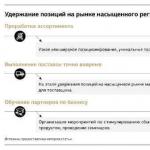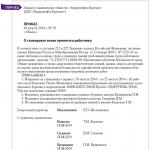Industrial production personnel of the organization include: Concept, composition and structure of the enterprise personnel. Tasks of the organization's production personnel
35. The condition for applying time-based wages is...
a. impossibility of accurately recording work performed (*answer*)
b. availability of a limited range of works
c. the need to stimulate workers to increase production
d. Availability quantitative indicators work directly dependent on a specific employee
36. The condition for applying piecework wages is...
a. strict regulation of the production process
b. the need to stimulate workers to increase production (*answer*)
c. functioning of flow and conveyor types of production
d. constant increase in workers' qualifications
37. Personnel turnover at a company (enterprise) is determined
a. ratio various categories employees in their total number
b. shift ratio
c. ratio of hired and retired employees (*answer*)
d. staff attrition rate
38. According to a single tariff schedule, tariff rate is …
a. absolute amount of wages for workers per unit of time (*answer*)
b. a set of tariff categories and tariff coefficients
c. official salary
d. set of tariff coefficients
39. In the wage system, the piece rate determines...
a. amount of remuneration for labor in excess of the established norm
b. absolute amount of wages per unit of time (hour, day, month)
c. tariff wage fund
d. amount of payment per unit of manufactured products (work performed) (*answer*)
40. To the method of material incentives innovation activity employees of the company include...
a. bonus for work without marriage
b. bonus for extracurricular work
c. awards for inventions (*answer*)
d. salary increase
41. Time wages depend on...
a. quantity of products produced
b. amount of time worked (*answer*)
c. worker productivity
d. capital-labor ratio
42. Labor productivity is expressed in terms of...
a. cost, natural
b. natural, conditionally natural, cost, labor (*answer*)
c. cost, normative, natural
d. man-hours, man-days
43. With a time-based wage system, the wage fund is calculated...
a. piece rate and time worked by employees
b. piece rate and tariff rate
c. piece rate and volume of work performed
d. tariff rate, time worked by employees and bonuses (*answer*)
44. The elements of the tariff system of remuneration do not include...
a. piece rate (*answer*)
b. tariff category
c. tariff rate
d. tariff coefficient
45. The main methods for measuring labor productivity do not include the ___ method.
a. Balance sheet (*answer*)
b. natural
c. labor
d. cost
46. Indicator reflecting volume products sold per one average employee industrial production personnel is called...
a. labor intensive
b. labor costs
c. labor productivity (*answer*)
d. capital-labor ratio
47. Additional wages do not include...
a. vacation pay (*answer*)
b. payment for study holidays
c. surcharge according to the regional coefficient
d. payment for government duties
50. The volume of products produced by one employee of an enterprise per unit of time is called...
a. complex labor intensity
b. labor intensive
c. renewal rate
d. production (*answer*)
51. Piecework wage does not depend on...
a. piece rate
b. volume of work performed
c. worker category
d. amount of time worked (*answer*)
53. The idea of rationing work activity, based on the timing of work operations, belongs to the basics...
a. schools scientific management(*answer*)
b. schools of human relations
c. behavioral school of management
d. School of Management Science
54. The main forms of remuneration for workers are...
a. piecework and progressive
b. daily, monthly, quarterly, annual
c. piecework and time-based (*answer*)
d. tariff and official salaries
55. What category of workers do accountants and lawyers belong to?
a. workers
b. specialists (*answer*)
c. employees
d. managers
56. Which of the following categories of workers belong to industrial production personnel
a. workers in the workshop, canteen and utility room
b. workers of the tool shop, warehouse and transport workshop
c. shop workers, engineers, security workers and students (*answer*)
d. workers kindergarten and holiday homes
TO industrial production personnel include workers employed directly in production activities and production maintenance: employees of main and auxiliary workshops, plant management staff, laboratories, research and development departments, computer centers.
Non-production personnel– workers serving non-industrial farms and enterprise organizations. These include employees of housing and communal services, children's and medical institutions, dispensaries, educational institutions and buildings on the balance sheet of the enterprise.
The industrial and production personnel of the enterprise form workers And employees(Table 2.8).
Table 2.8.
Composition of industrial production personnel of the enterprise
Workers– workers directly involved in the production of products, as well as the repair and maintenance of equipment, the movement of objects of labor and finished products. This group also includes junior service personnel - workers who perform functions of caring for office premises and servicing workers.
Managers– employees employed in management positions at various levels. According to the management structure, managers are divided into linear and functional; at management levels - at the top, middle, and lower levels.
Specialists– workers engaged in engineering, economic, accounting, legal and other activities.
Technical performers– workers involved in the preparation and execution of documents, accounting and control, and business services (clerks, secretaries, agents).
The ratio of the listed categories of workers to their total number, expressed as a percentage, is called personnel structure.
Each category of workers includes a number of professions, which in turn are represented by groups specialties. Within a specialty, workers can be divided by level qualifications(for workers - by qualification categories, and for specialists - by qualification categories).
Profession– a set of special theoretical knowledge and practical skills necessary to perform a certain type of work in any branch of production.
Speciality- a division within a profession that requires additional skills necessary to perform a certain type of work in any branch of production.
Qualification– a body of knowledge and practical skills that allows you to perform work of a certain complexity.
The concept of “personnel composition”, which is used in the practice of personnel accounting and planning, should be distinguished from the concept of “personnel structure”.
There are attendance, list and average personnel compositions.
Attendance is the minimum required number of workers who must come to work every day to complete the task within the established time frame. Payroll - all permanent and temporary workers listed at the enterprise as performing this moment work, and those on regular vacations, business trips, performing government duties, who did not show up for work due to illness or some other reason. The average payroll is determined by summing the payroll of employees for all calendar days of the period, including weekends and holidays, and dividing the resulting amount by the full calendar number of days of the period.
The personnel of an enterprise is not a constant: some workers are fired, others are hired. In this regard, the staff turnover rate is determined ( TO T):
TO T = [ H uv / H Wed ] 100, (2.37)
Where Ch uv- the number of retired or dismissed employees for a certain period.
| " |
Enterprise personnel - the main (regular) composition of the enterprise's employees. Depending on the functions they perform enterprise personnel are divided into the following categories: primary and auxiliary workers; managers; specialists; employees. The listed employees form (at manufacturing enterprises) industrial production personnel (PPP).
Staff industrial enterprises divided into industrial and non-industrial personnel. TO industrial production personnel include persons engaged in labor operations related to the main activities of the enterprise non-industrial Personnel include persons whose work activity is related to the performance of work related to other sectors of the economy. Industrial production personnel are divided into workers and employees, which include managers, specialists and other employees
Personnel numbers indicators. Indicators of turnover and staff turnover. Labor productivity as an indicator of efficiency of use labor resources, production and labor intensity of products
There is a sum of 3 indicators: - employees of all enterprises and organizations of all forms of ownership, whose activities are legally formalized; persons engaged in individual labor activity; unpaid workers in family businesses.
Staff turnover- movement work force, due to the employee’s dissatisfaction with the workplace or the organization’s dissatisfaction with a specific employee.
Fluidity may be :- Intra-organizational- related to labor movements within the organization; -External- between organizations, industries and sectors of the economy. Distinguish natural and excessive staff turnover. STAFF TURNOVER RATIO - the ratio of the number of dismissed employees of an enterprise who left during a given period for reasons of turnover (by at will, for absenteeism, for violation of safety regulations, unauthorized leaving, etc. reasons not caused by production or national needs) to the average headcount for the same period.
Natural fluidity(3-5% per year) contributes to the timely renewal of the team and does not require special measures from management and personnel service. Excessive fluidity causes significant economic losses, and also creates organizational, personnel, technological, and psychological difficulties. Labor productivity characterizes the efficiency, effectiveness of labor costs and is determined by the amount of products produced per unit of working time, or labor costs per unit of products produced or work performed. At enterprises, labor productivity is defined as the cost-effectiveness of only living labor and is calculated through indicators of output and labor intensity of products, between which the relationship is inversely proportional. Output- the amount of products produced per unit of working time, or per one average employee. T ore intensity- labor costs and working time to produce a unit of product. Labor intensity is inversely proportional to labor productivity, output per worker.
For the functioning of an economy at any level, a certain number, composition and structure of workers are necessary, i.e. personnel or labor resources.
At the core classifications personnel composition is based on the principle of participation of individual groups of workers in production process, i.e. the nature of the functions performed. In accordance with this, workers are divided into industrial production personnel and non-industrial personnel.
Towards industrial production personnel include those involved in the production process, carrying out its preparation, technical and organizational services, and management.
Non-industrial personnel– these are employees serving non-industrial, non-production facilities (housing, child care facilities, medical services, recreation centers, cultural centers) listed on the balance sheet of the enterprise.
Industrial and production personnel are divided into groups in accordance with their functions:
- managers; - specialists; - employees; - workers; - security - students.
Leadership group– persons carrying out linear and functional management consists of: the head of the enterprise (including his deputies, chief specialists), heads of departments, services, workshops, and sections. In mechanical engineering there are 62 positions.
Specialists– employees performing engineering, technical, economic, accounting and other functions (in mechanical engineering this is 51 positions).
Employees– persons involved in documentation, office work, and economic services (in mechanical engineering – 19 positions).
Workers- these are persons directly involved in production and its maintenance, divided into two groups: main and auxiliary.
Essential workers directly involved in the manufacture of products.
Auxiliary workers are busy servicing the main production. These are repair workers, product quality inspectors, storekeepers, and transport workers. Auxiliary workers work either in the auxiliary workshops of the enterprise or in the main workshops. They participate in the manufacture of products indirectly, creating the necessary material conditions for conducting main production.
Employees of enterprises are classified according to professional and qualification characteristics. Within the profession there is specialties- this is a more specific characteristic of a certain profession, accurately showing the scope of a person’s activity, requiring special knowledge and skills in a specific type of activity. Professional division takes place among a group of managers ( chief mechanical engineer, Chief Power Engineer, chief designer, etc., as well as heads of specialized departments and services), from a group of specialists (technologists, designers, economists, etc.), from a group of workers (machine operators, mechanics, electricians, etc.). In the group of employees, the professional characteristic is weakly expressed. The qualification characteristic is more pronounced among specialists and workers. Among specialists, it is expressed at the category level (no category, 3rd, 2nd, 1st category, leading specialist). For workers, the expression of qualification is a rank (mostly 6 ranks, and in a number of professions 8 ranks).
The relationships between individual groups of workers give an idea of the personnel structure at a given level of the economy. From the point of view of participation in the production process, workers have the largest share in the personnel structure.
Personnel training is carried out through the system of higher and secondary specialized education - training of managers at various levels, most specialists, and some employees; Vocational schools, lyceums – some employees and workers; at the enterprise - workers.
The efficiency of an enterprise depends 70-80% on its manager. It is the leader who selects the team for himself and determines personnel policy at the enterprise. A lot depends on how he does it. If the company does not have long-term plan development of the enterprise, if there is no strategy for the long and short term, it means that all this is not in the head of the manager. In this case, consider that the company has a bad future. Therefore, at every enterprise, the main core of personnel policy should be the selection and placement, first of all, of managers at various levels.
The efficiency of using labor at an enterprise to a certain extent depends on the structure of the enterprise's personnel - the composition of personnel by category and their share in the total number.
Per structure PPP the following factors influence:
¨ level of mechanization and automation of production;
¨ type of production (single, small-scale, large-scale, mass);
¨ size of the enterprise;
¨ organizational and legal form of business;
¨ complexity and knowledge intensity of manufactured products;
¨ industry affiliation of the enterprise, etc.
Personnel policy at the enterprise should be aimed at the optimal combination of PPP categories.
The personnel management process requires that at each enterprise the structure of the workforce is determined and analyzed by gender and age composition, as well as by skill level. This is necessary in order to prepare replacement personnel in a timely manner, as well as to achieve the most acceptable personnel structure for the enterprise by gender and age, by skill level and other characteristics.
The company's personnel and its changes have certain quantitative, qualitative and structural characteristics, which can be measured with less or more certainty and reflected by the following absolute and relative indicators:
¨ list and attendance number of employees of the company and / or its internal divisions, individual categories and groups on a certain date;
¨ shares of workers of certain categories with higher, secondary specialized education in their total number;
¨ the average number of employees of the company and/or its internal divisions for a certain period;
¨ the share of employees of individual divisions (groups, categories) in the total number of employees of the company;
¨ rate of growth (increase) in the number of employees of the company for a certain period;
¨ average category of workers of the enterprise;
¨ the proportion of employees with higher or secondary special education in the total number of employees and/or employees of the enterprise;
¨ average work experience in the specialty of the company's managers and specialists;
¨ staff turnover;
¨ capital-labor ratio of workers and/or workers at the company, etc.
The combination of these and a number of other indicators can give an idea of the quantitative, qualitative and structural state of the company’s personnel and trends in its change for management purposes staff , including planning, analysis and development of measures to improve the efficiency of use human resources enterprises.
Quantitative characteristics of personnel firms are primarily measured by such indicators as payroll, turnout and average number workers. Headcount employees of the company ¾ is an indicator of the number of employees on the payroll as of a certain date, taking into account the employees hired and departed for that day. Turnout number¾ is the estimated number of payroll employees who must report to work to complete the production task. The difference between turnout and payroll composition characterizes the number of full-day downtime (vacation, illness, business trips, etc.).






